Sharpmony Harmony Rules
The harmonic error controls available in Sharpmony are shown below. The information includes the CONTROL that allows you to activate or deactivate its use in the APP, the COLOR used to mark the errors found in the score, explanatory text of the harmonic rule and its exceptions and finally graphic examples that explain how the marked error appears in the score.
Don't let your voice parts cross, so no voice may cross (ascending or descending) the note that another voice has just sung.
Exception
- Between Tenor and Bass in V-I (or I-V) progression, when the leading tone resolves to tonic and this is doubled in unison by the bass.
Sharpmony will detect the crossing and will mark it, on the first chord with the assigned color, the 2 notes corresponding to the 2 crossed voices.
The following figure shows an example corrected by Sharpmony. The arrows shown and the text have been added over the Sharpmony correction to make it clear why the notes are marked (or not) with the color ORANGE corresponding to the crossing of voices.

The maximum distance between 2 adjoining voices will be one octave, except between the tenor and the bass whose distance will be free.
Sharpmony will detect when this distance is exceeded in any chord and will mark the 2 notes with the problem with DARK TURQUOISE color.
In the following example corrected by Sharpmony, the circles with arrows and text have been added above the correction and indicate when the maximum distance is allowed and when it is not.
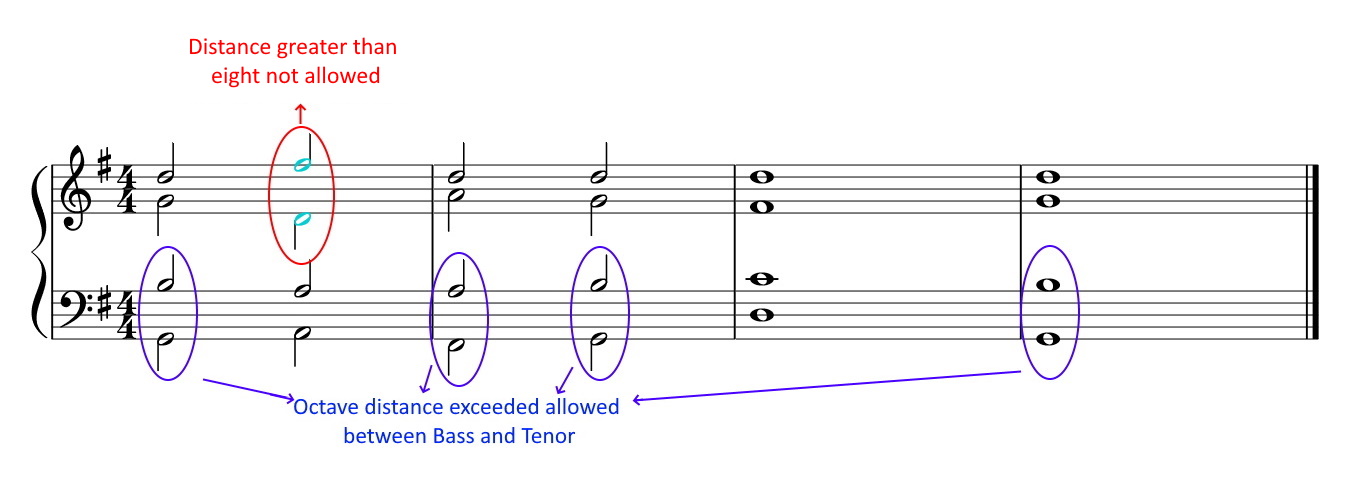
Consecutive parallel octaves between the same pair of voices, in both parallel or contrary motion, are not allowed. Nevertheless, oblique movement is allowed.
Exception
- Consecutive parallel octaves are allowed as long as they occur in a chord disposition change, or in two consecutive chords featuring the same dominant functionality (V-VII or vice versa).
Sharpmony will detect the parallel octaves that are not allowed, and will mark the 2 notes corresponding to the 2 voices that produce the parallel octave in the first chord, using RED color.
The lines, numbers, as well as the text in the following example have been added to the Sharpmony correction to better show where the octaves are located.

Consecutive parallel fifths between the same pair of voices in parallel or contrary motion are not allowed, although oblique movement is permitted.
Exception
- Consecutive parallel fifths are allowed when the second is a diminished fifth.
- Consecutive parallel fifths are allowed as long as they occur in a chord disposition change, or in two consecutive chords featuring the same dominant functionality (V-VII or vice versa).
- Consecutive parallel fifths are allowed when the German Sixth chord is used, which requires consecutive parallel fifth to resolve. Only allowed if Soprano and Bass voices are not simultaneously involved.
Sharpmony will detect the parallel fifths that are not allowed, and will mark the 2 notes corresponding to the 2 voices that produce the parallel fifth in the first chord, with RED color.
The lines, numbers, as well as the text in the following example have been added to the Sharpmony correction to better show where the fifths are located.

Hidden consecutives, Fifth and Octave, (by direct movement) will be allowed when inner voices are involved, as long as one of the voices moves by step. In the case of soprano and bass voices, it will be allowed only when the soprano moves by step.
It will also be allowed in a change of disposition between 2 chords of the same dominant functionality (V-VII or vice versa), so that harmony is not changing, without the need of step motion.
In the case of contrary or oblique motion, both the fifth and octave will be allowed regardless of whether they move by step.
Sharpmony will detect not allowed motion, and will mark it in the first chord the 2 notes with wrong motion, with LIGHT PINK color.
The lines, numbers as well as the text in the following example have been added to the Sharpmony correction to make it clearer.

This will occur when a chord does not contain the correct notes or when the accidentals belonging to the current key have not been correctly assigned. This will also happen when a mandatory inversion for a given chord is not applied to the chord (such as augmented sixth).
Sharpmony will detect the modulations of the exercises and will check whether the chords belong to the key, taking into account the current key, and in the case of a mismatch will mark the chord or chords as wrong with the GREEN color.
In the following example, explanatory text has been added to the Sharpmony correction.

All the voices are assigned a maximum tessitura both towards the treble and towards the bass, always thinking of a choir of amateur voices. The maximum tessitura of the voices are shown in the figure:
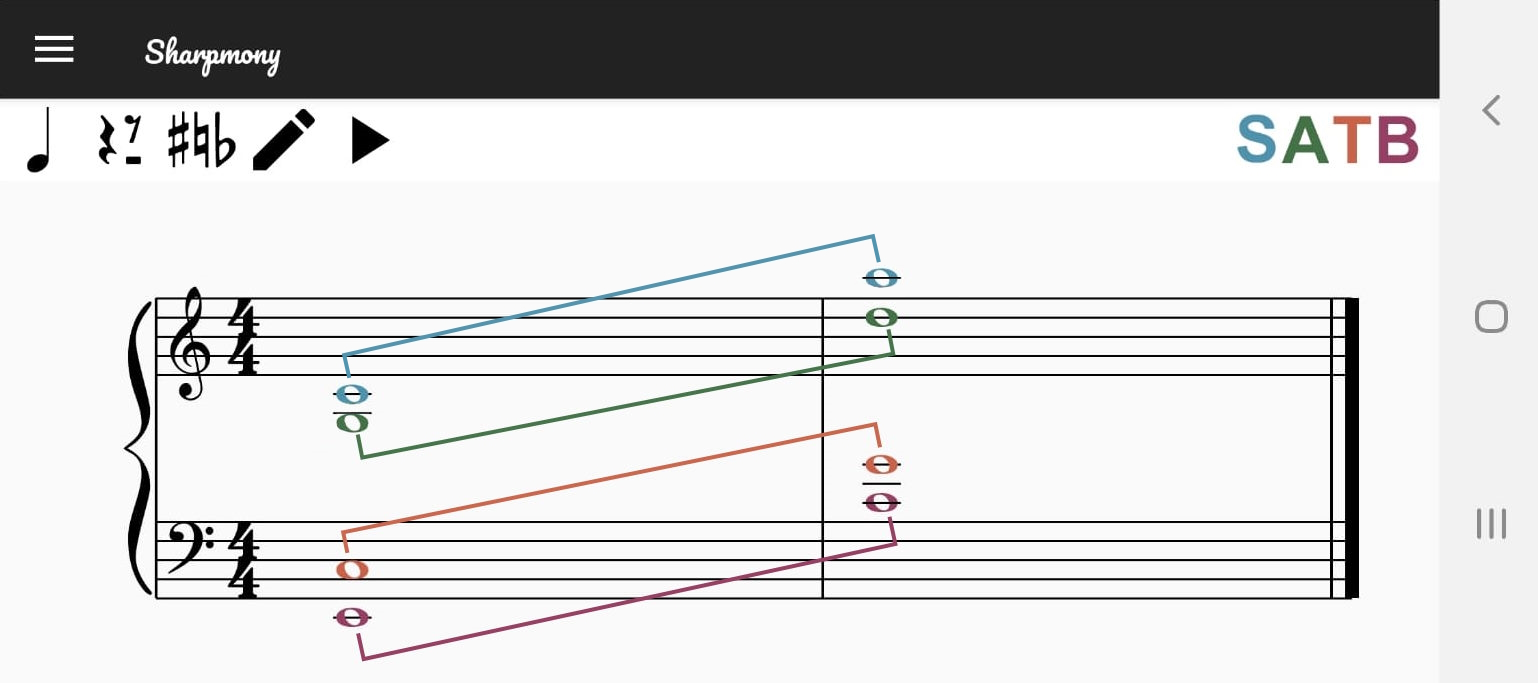
If any of the voices exceeds the maximum tessitura, Sharpmony will detect and mark them, with the assigned color, CHOCOLATE.

Dissonant leaps must be avoided: augmented or diminished, as well as 7th and 9th leaps. Sharpmony will detect and mark the corresponding note with BLUE color.
Exceptions
- Dissonant leaps will be allowed as long as they occur in a chord disposition, or in two consecutive chordsfeaturing the same dominant functionality (V-VII or vice versa).
- If after a dissonant leap the melodic movement continues by stepwise contrary motion, it will be allowed and no error will be marked.
The lines, boxes, numbers as well as the text of the following example have been added to the correction provided by Sharpmony.

The term describes a chromatic contradiction between two notes sounding in close proximity: If they are consecutive sounds in a single voice, it is allowed. Otherwise, if they belong to different voices, Sharpmony will detect and mark the notes using a DARK GOLDEN color.
Exception
- If TENOR or ALTO voices are involved in False Relation, it will be allowed.
The lines, boxes, numbers as well as the text of the following example have been added to the correction provided by Sharpmony.

Any Diminished 5th , 7th or 9th belonging to a chord featuring dominant function, must be prepared from the previous chord -with no motion or stepwise motion- and must resolve be downward stepwise motion, either chromatic or diatonic movement.
Exceptions
- Above describe rule is not mandatory if the movement belongs to a chord disposition change when working as a dominant chord (V-VII or vice versa).
- Both indirect preparation and resolution are also allowed, provided that an adjoining voice prepares or resolves the note.
The lines, circles and text in the following example have been added to the correction provided by Sharpmony.

(*) When a leading-tone seventh chord is to be used (diminished or half-diminished), the control corresponding to seventh diatonic chords must be on so that the chords can be appropriately checked.
When two voices movement produces unison interval, it is required that both the movement before and after that unison must follow contrary or oblique motion.
Exception
- If unison is reached by parallel motion between tenor and bass, and scale degrees progression in the two chords involved are among the following ones, then the movement is not considered wrong: V-I / I-V ó IV-I / I-IV.
Sharpmony will detect and mark the corresponding interval BURGUNDY color.
The lines, circles and text in the following example have been added to the correction provided by Sharpmony.

When the chord after a dominant one includes the root, the leading note must resolves into the root.
Exceptions
- When the root is not part of the next chord, the leading tone can stay or move stepwise ascending, but never descending.
- If the leading note is part of the 3rd scale degree chord (therefore not featuring dominant function) it can move freely.
- If we have reached the leading tone from the root, it can move freely.
- When the movement is part of a chord voicing change (same chord or two consecutive dominant chords, V-VII), restrictions does not apply.
- The leading tone may indirectly resolve to root in a different upper voice, but only if the leading note is not in the SOPRANO and is part of a dominant chord. This indirect resolution masks the wrong movement of the leading tone in a given voice.
Sharpmony will detect wrong leading note movements and mark the corresponding note with LIME color.
Circles and text in the following example have been added to the correction provided by Sharpmony.

(*) Se muestra a continuación un ejemplo de la Excepción 3, en el que se muestra el mantenimiento de la sensible en varios acordes después de una tónica, y cómo después dicha sensible se mueve libremente sin que la app marque error.
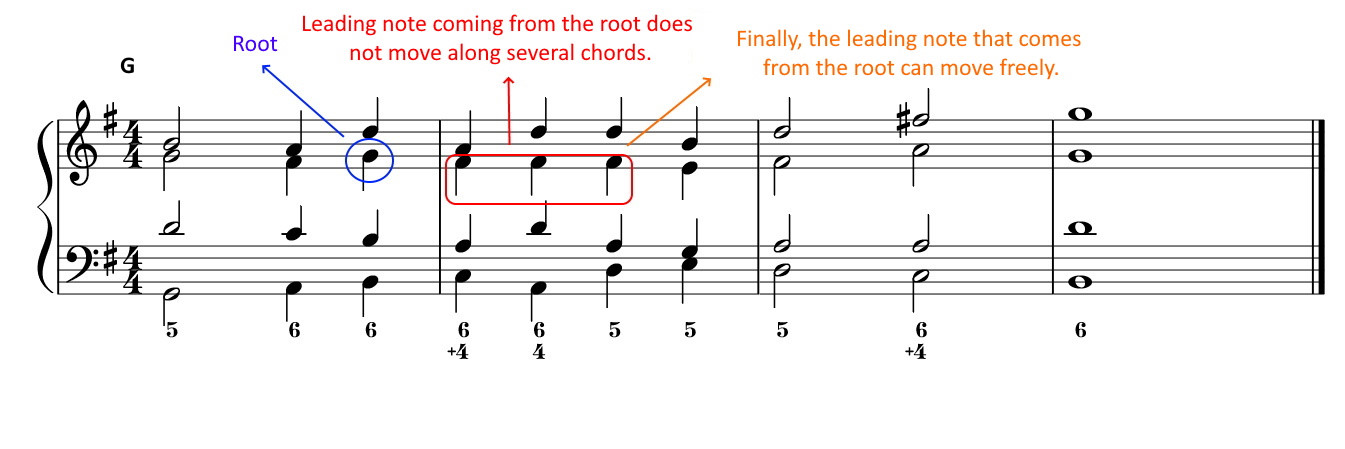
If the third of a chord is missing, Sharpmony will detect and mark that chord with SALMON.

In some situations, specific notes can not be doubled in a chord:
- A) Minor flatted 5th (diminished triad). The root cannot be doubled when the chord is in the root position or second inversion, given that it must follow an established resolution.
-
B) First inversion triad chord (6): the note in the bass cannot be doubled. Yet some exceptions may apply
- First inversion of the minor flatted 5th: only the note in the bass can be doubled, It is the only one without a mandatory resolution.
- First inversion triad chord: The note in the bass can be doubled if there was a mandatory movement required for the bass note in the previous chord that led to this note.
- When using a first inversion of the Napolitanean chord, the note in the bass can be doubled.
-
C) Seventh or Ninth chords: None of the notes in the chord can be doubled. Some exceptions may be applied:
- In a Dominant seventh chord in root position, the root may be doubled if the 5th is removed, so that the chord is incomplete.
Sharpmony will detect and mark wrong notes doubled using FUCHSIA color.
Boxes and text in the following example have been added to the correction provided by Sharpmony.
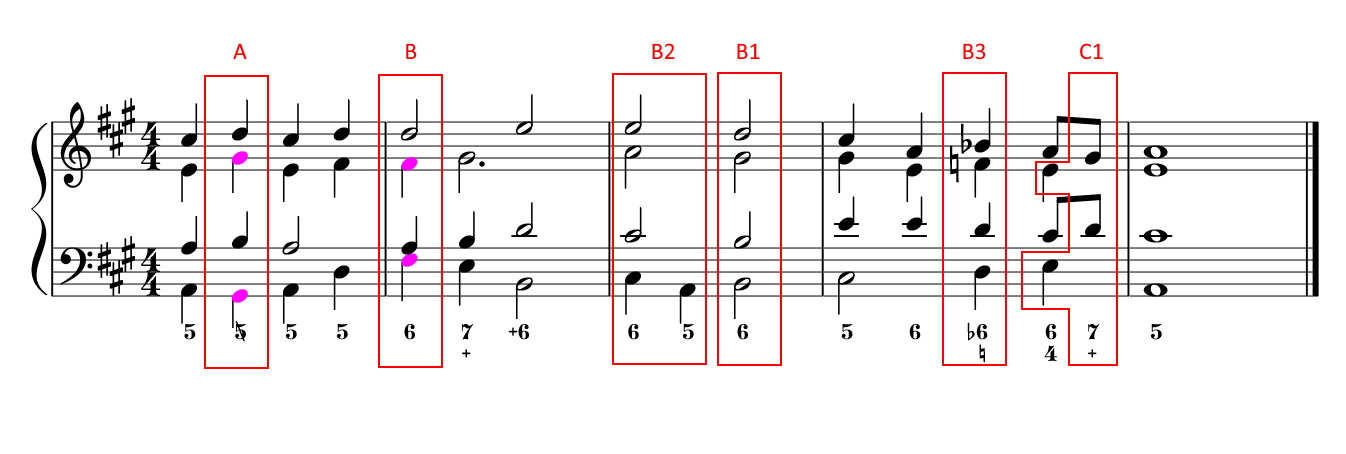
Chord progressions using a single tonality and also using modulations can be used.
Boxes and text in the following example have been added to the correction provided by Sharpmony.

Consecutive first inversion chords
Several consecutive first inversion triads with parallel movement may be used.
Firstly, one of the voices is removed, usually the tenor or alto. Then the root is assigned to the soprano, thus avoiding parallel 5th or 8th among the consecutive chords. This produces a parallel movement of three voices.
At least 3 consecutive first-inversion chords must be present to consider them as a series of first-inversion chords. The first and last chord of the series must be complete. If the key of the exercise is in a minor mode, the series should not use the VII degree as a leading note, unless indicated by the figured bass.
Sharpmony will apply the error controls previously described.

(*) In all chord progressions Sharpmony will analyze the pattern that gives rise to the progression, and will mark the beginning and end of the progression with open bracket “(” on the note of the soprano voice corresponding to the first chord of the progression; and closing bracket “)” on the note of the soprano voice corresponding to the last chord of the progression; and will point out any error detected within the progression, according to the following considerations.
In the case of repetitions of the model detected within a progression, certain errors are allowed as long as they are not considered as such in the original model. That is, if the model is correct, some errors in the repetitions will be acceptable. These allowed errors, include:
- Parallel 5ths and 8ths
- Direct 5ths and 8ths
- Dissonant movement.
- Incorrect resolution 7th, 9th.
- Wrong movemento of leading tone.
- Wrong note duplication.
Likewise, if the model contains any of these allowed errors, they will not be marked in the repetitions either. However, if the progression control is deactivated, all errors in the score will be checked.
Series of diatonic seventh chords as well as dominant seventh chords are allowed with a descending bass motion. Two possibilities are available:
- Incomplete chord following a complete one (or vice-versa): One of the voices will move by 4th or 5th leaps. Both fundamental or chord inversions are allowed for the chords in the series.
- All the chods in the series are complete: All the voices will feature stepwise descending motion or no motion. All the chords feature any of the available inversions (no fundamental disposition used).
Series of seventh diatonic chords

Series of seventh dominant chords

(*) As explained before, leading-tone seventh chords need the seventh diatonic chord control on to be properly checked by Sharpmony.
A secondary dominant is an altered chord (a chord containing at least on tone that is foreing to the key), having a dominant or leading tone relationship to a chord in the key other than the tonic.
Sharpmony allows to disable the use of secondary dominants. When they are dissable, if a secondary dominant is detected it is marked as a wrong chord. Otherwise, the note motions in the chord will be checked according to their dominant funcion.
The boxes and text in the following example have been added to the Sharpmony correction.

Modulations are detected anc checked by Sharpmony, considering both note motions and chord progressions.
- Common-chord modulation: moves from the original key to a destination key by way of a chord that both keys share. After the shared chord, V-I chords in the new key are required.

- Chromatic modulation: It involves the chromatic inflection in one or more notes, whose name remains, and is altered through an accidental. After that inflection, V-I chords in the new key are required.

- Enharmonic modulation: This modulation uses the diminished seventh chord of a key, that is enharmonically written to correspond to the diminished seventh in the destination key.
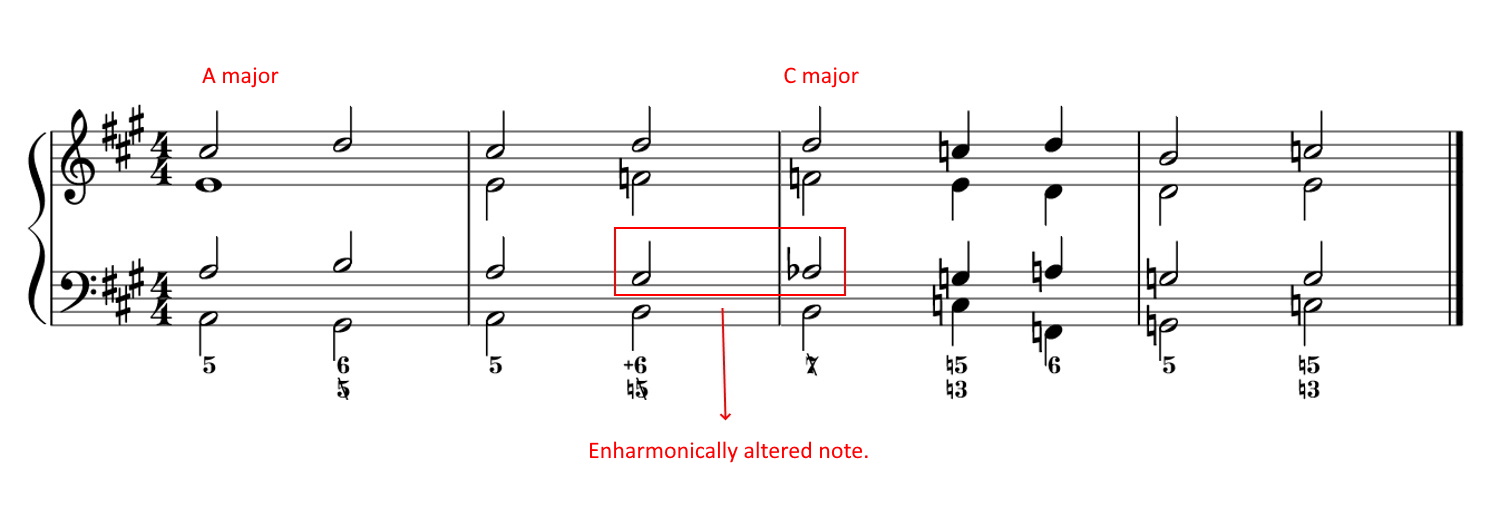
- Modulation to parallel keys: We can move from major mode to a minor mode (or viceversa) be altering the third of the I. It is technically know as a change in mode.

- Modulating up a third (or 6th): Two triads are used whose fundamentals are a third or sixth apart (major or minor). Usually employed when considering the I or V in two different keys. Different possibilitis allowed:


Sharpmony will detect modulations and checked chords and notes according to that modulations. If a modulation detected is not allowed, it will be marked using ULTRAMARINE color.
Example of how Sharpmony shows wrong key modulation

The boxes and text in the following example have been added to the Sharpmony correction.
Sharpmony allows the use of Figured Bass and Scale Degree, and will check their correct correspondence with the chord. If the figured bass does not correspond with chord inversion or scale degree with the chord, it will be marked using MUSTARD color.

Augmented Sixth Chords
These chords work with a pre-dominant function, resolving on a dominant chord (V7, VII). The name of the chord is due to the use of its diminished 5th when V->V movement is used: when placed on the bass voice, it produces an augmented sixth with the third in chord. When a VII->V movement is applied, the third of the VII chord corresponds to the dimisnished 5th in the V chord, and this is the note placed in the bass voice.
There are three main types of augmented sixth chords:
- Italian sixth Diminished triad formed over the leading of the Dominant. It must necessarily feature a first inversion.The diminished 5th is doubled. When resolving to the dominant of the tonality, given that the diminished 5th is doubled, one of the will resolve down by step, while the other will ascend by step.
- French sixth: Dominant Seventh cuatriad (with diminished fifth) of the dominant chord. It must necessarily feature a second inversion.
- German sixth: Diminished 7h chord of the Dominant (VII/V). When resolving to the dominant two parallel fifths are formed that are allowed if Soprano and Bass are simultaneously involved. It must necessarily feature a first inversion.
When Augmented sixth control is set, these chords are recognized and allowed and will check if they are properly shaped and their voice motions correct. Otherwise, error colors will mark the errors found.
Boxes, lines and texts had been added to the figure provided by sharpmony.

Neapolitan Chord
A major triad whose fundamental is the lowered second scale degree (II6). Usually this chord is used in its first inversion, thus placing the fourth of the scale degree in the bass, which is doubled in another voice.
The note with the sixth interval with the bass must be placed above the third. The voice leading is as follows:
- The bass moves up to the I in a cadential 6/4.
- The other voices moves down.
When sixth chords are allowed, sharpmony will check if the chord is properly shaped and voices move as they should. Accordingly, error colors will be used in the score to show errors detected.

The use of ornaments (we consider here passing notes and flourish) are allowed in Sharpmony. These ornament notes are also called extraneous notes to the harmony and consist of any note that does not belong to the chord employed.
They will always appear in the weak part (meaning weak part, i.e. whenever they do not coincide at the same time with the chord in function at the time) and may appear 1, 2, or 3 consecutive ornament notes.
Sharpmony will detect the passing notes and/or flourishes of the exercise and will not mark errors that otherwise will appear if they were consider real notes of a given chord.

Over a pedal tonic (root of the first degree in the bass) a dominant, half-diminished or diminished chord is placed in the other voices. This kind of chord was initially used for embellishment. Their functionality does not change although the tonic is in the bass.
Their figured bass notation are as follows:
- Common-tone dominant chord: The fifth is not used in any voice. We use +7 as figured bass
- Common-tone Half-diminished chord The third is not used in any voice. We use +7/6 as figured bass.
- Common-tone Diminished chord: The same as with the half-diminished, adding the accidental to the figured bass.

The ii - V - I cadential chord progression can be extended harmonically by adding the delay 4-3 or sus4 chord over the V or I degree chord, or both at the same time. This chord belongs to the group of suspended chords that momentarily suppress the third and includes the fourth. It will be used in root position, with the bass -root- doubled and the note that produces the delay must be prepared or reach it by an ascending leap movement, resolving in the opposite direction. To use this chord, the “Allowed SUS4 chords” control must be activated. Otherwise, and even if you write the corresponding chord, Sharpmony will mark it as a wrong chord:

When the “Allowed SUS4 chords” control is activated, and provided that the chord is arranged correctly, Sharpmony will return the following:
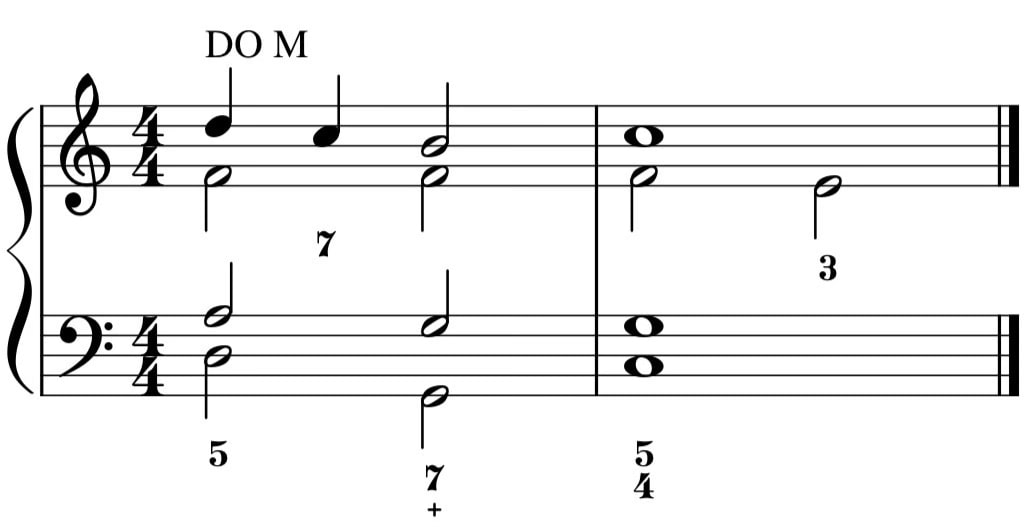
No error detected nor marked, given that the chord is correctly written.
The melodic minor check box must be set if altered chords corresponding to melodic minor scale are to be used. Otherwise, these chords will be marked as wrong chords by Sharpmony using OLIVE GREEN color, as shown below.

If this control is set, then this kind of chords are allowed, and therefore Sharpmony will not mark them as wrong chords.

Some notes require specific movements and resolutions when using the melodic minor scale, as described below:
Ascending movements.
- The lead note (#VII) should move upward to the root.
- The altered sixth (#VI) should move upward to the lead tone. Altered VI is thus a melodic consecuence of the VII altered degree.
Descending movements.
- Natural VII degree should move downards to the natual VI degree. Both notes are part of the natural minor scale.
- Natural VI degree must move downwards to the V degree, if this is part of the next chord, or instead in any other different from the #VII. The VI degree is both parto f the natural and armonic minor scales.
In this case, the exceptions regarding lead note movement do not apply, given that melodic movements are mandatory.
Talking about modal exchange means using chords of other modes parallel to the original within the same tonal center. The use of these chords cannot separate you from the tonality and their use cannot give the idea of a modulation.
In the major mode, the modal exchange chords arise from the Aeolian mode and are related to the area of the Minor Subdominant. The most used are ii, ii7, iim7(b5), bIV and bVII (among others).
To be able to use these chords in Sharpmony you must have activated the correction control "IIb5, bIV, bVI and bVII chords borrowed in the minor mode", because if it will not mark the error "Incorrect chord or not belonging to the tonality".
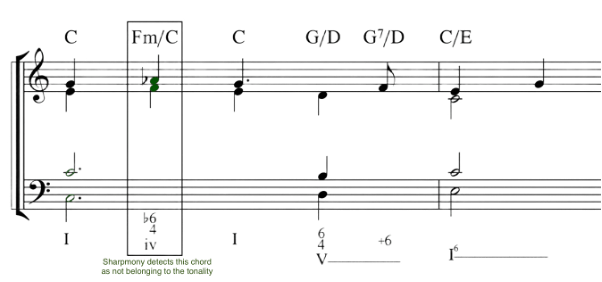
By having the control activated, Sharpmony will not detect those chords as not belonging to the tonality.
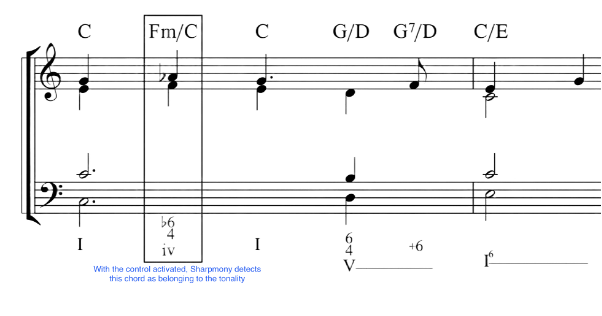
Observations
Figured Bass: Exercises can be performed without figured bass, so that the app will not check if the chord corresponds to a given figured bass.
Rests: Sharpmony only analyses chord notes, so in the case of rests it will mark error, if the remaining notes does not correspond to a proper chord.
Scale Degree: Exercises can be performed by marking the corresponding degrees associated to chords employed. Sharpmony will analyze the adequacy of the degree with the chord and the key and, if necessary, will mark an error.
Error checking: In order for Sharpmony to analyze and mark specific errors, users must set the error checks by selecting those errors that we want Sharpmony to detect.
Bibliography: Harmony Rules employed have compiled from:
- Harmony, 5th edition, Walter Piston. WW Norton & Co.
- Tratado de Armonía, Joaquín Zamacois, Span Press Universitaria.
- Armonía Tonal, Luis Blanes, Real Musical.
Creators: Sharpmony ha sido ideado y creado por:
- Project management and A.I. development: Francisco Fernández de Vega
- Web and Apps Development: Jorge Alvarado Díaz
- Web editor: Abel Sánchez Venegas
- AI Development: Elia Pacioni
- File compatibility management between different musical formats: Juan Pérez Villegas
Consultants: Sharpmony has also been advised by:
- Juan Antonio Rodríguez García, Harmony teacher at the Conservatorio Profesional de Música "Luis Gordillo", Montijo, Badajoz.
- José Bugallo Senra, Harmony teacher at the Conservatorio Profesional de Lalín, Pontevedra.
- José Ignacio de la Peña, Director of the Conservatorio Oficial de Música "Estaban Sánchez", Mérida, Badajoz, and Harmony teacher at the same.